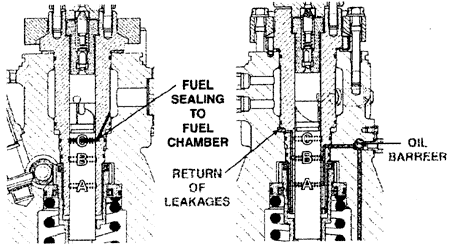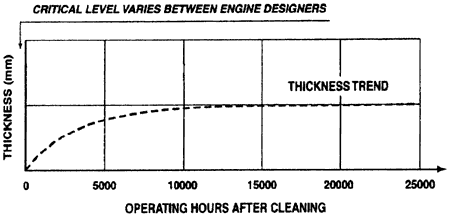F. INTERACTION OF HFO AND LUBRICANT
Several parameters of both lube oil and heavy fuel can interact each other -for example a lubricant (typically paraffinic) may interact with aromatic heavy fuel to cause asphaltene precipitation. A major parameter to consider also is the quality of fuel which will generate different degree of stress on lube oil according to the fuel ignitability, combustibility, sulphur condition.
a) Fuel pump plunger sticking. A particular point of concern about fuel is the so called "raw fuel contamination" Because of areas like injection pumps and/or ring pack area there is a possibility of ingress of raw or partially burnt fuel into the oil. By so the fuel can precipitate and foul the oil circuit and the engine with asphaltenes commonly known as "black sludge" (See Ref. 3).
The industry worked on that problem during the recent years and found two different solutions:
1) The new chemistry new generation oils are less sensitive to fuel incompatibility problems, and hence have reduced sludge and asphaltene build up.
2) The engine builders have addressed the problem by improving design of injection pump (major source of pollution) in order to reduce or stop the risk of contact between the fuel and the barrier oil on the fuel pump plunger and barrel.
Re point [2] above, a typical answer is an injection pump barrel with several grooves, usually with 3 grooves, (see Fig. 8).
i) the upper groove - one where the heavy fuel leakages are collected and returned back to the main fuel chamber of the injection pump, (Groove C of Fig. 8),
ii) the middle groove - for recovering any fuel leakages from upper groove or oil from lower; the captured fuel/oil are drained away to the outside of the pump (Groove B of Fig. 8),
iii) the bottom groove - the final barrier for sealing the injection pump, (Groove A of Fig. 8).

Fig. 8 - Injection pump.
On the problem of fuel contamination, it is important to monitor the quality of the affected lubricating oil in use.
This bulletin, also gives guidance on other points of concern such as:
b) Piston Undercrown Deposits (see Fig. 9). On this point the main conclusion of the WG are:
- Deposit formation is influenced by piston design (through temperature and coolant flow patterns), fuel contamination and lubricant quality.
- Undercrown deposits can lead to serious mechanical problems.
- Latest generation of 4 -stroke diesel lubricants are more likely to prevent deposits.
- For both 2 stroke and 4 stroke diesel engines, ensure that the oil in service remains within established quality limits at all times.

Fig. 9 - Piston undercrown deposits.
c) Matching lubricant basicity to fuel sulphur content.
The major comments of the WG are given below.
- Base Number (BN) provides a benchmark of anti-corrosive properties of a lubricant.
- BN level of lubricant and sulphur content of fuel are directly related in a broad way.
- When S content of bunkered residual fuel varies widely, then higher BN oils are acceptable for lower S content fuels; but lower BN oils do not provide adequate protection in conjunction with higher S content fuels.
- Operational considerations other than neutralization of acidic compounds may demand BN levels in excess of perceived requirement of S content.
d) Low sulphur fuel operation. After reviewing all technical and typical aspects of problems that question the suitability of oil for low sulphur fuel situation, the WG gave following summary:
- Low and very low S contents fuels may result in poor engine condition, higher wear and deposits.
- Practical tips
・ latest formulation of high performance trunk piston diesel lubricants (marine and automotive) can be effective for anti-bore polishing control although not necessarily a solution for all engine and operational configurations.
・ use lowest BN possible lubricant for running-in compatible with maintaining engine cleanliness.
BACK CONTENTS NEXT